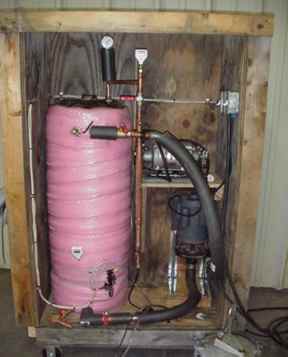 Veggie
pup's touchless processor
Veggie
pup's touchless processor
My biodiesel processor, out of the closet (sort of).
The enclosure is made of scrap plywood and lumber salvaged from a set
of shelves that the termites had found. If the resolution was better,
you could see termite damage on the upper left corner. There is
additional steel bracing that isn't visible, so no great loss of strength.
The dimensions were more determined by my reluctance to cut the plywood
than anything else. By sticking with the original plywood dimensions,
I didn't have to cut much of the framing, either. There are few
new parts or materials here.
Principal parts: Tank, vacuum/pressure pump, and mixing pump. And lots of valves. The vertical copper tube near the center is a condenser.
The tank was rescued from the trash collector. I spotted it in my neighborhood, lying next to the street. I had been looking for and electric water heater for some time, something in the 30 to 40 gallon range. This one was 30 gallons. It doesn't look like a water heater any more because I had to remove the outer shell and insulation to fix the leak.
The silver object on the shelf to the right of the tank is the vacuum/pressure pump. It was originally a part of an anesthesia unit; it has a sliding vane type pump on both ends of the motor shaft. In the anesthesia unit, one pump was used to pump ether under pressure while the other was used to supply vacuum for collecting, um, fluids.
Below the vacuum pump, the gray object is a 2hp centrifugal pump. I bought it from an acquaintance who had been storing it in his garage until I needed it :o). This one is probably overkill for the application, but all the pump parts are cast iron, so I'm really not worried about crazing plastic impellers. It is mounted vertically and raised somewhat from the level of the bottom of the tank to eliminate the chance that glycerin might congeal in it. In practice, the pump only has liquid in it during the mixing. Everything is sucked back into the tank immediately after mixing.
The tank is pink because of the insulation I used. I couldn't find
anything brighter.
Close-up
of the Vacuum Pump
One especially nice feature is the oil system. Each of the two pumps (one at each end) uses the glass bottle in the foreground as an oil reservoir, and an identical bottle (in the background, with only the top visible here) as an oil trap. If the oil becomes contaminated, changing it is easy.
The pump is capable of about 27" hg. The flow rate is outstanding
if the pumps are hooked in parallel or series. Only about 22"-25"
is really necessary for methanol recovery. The methanol will begin
boiling at 22" and 140F, and will be done at about 25".
The
Mixing Pump
The pump is mounted vertically, as noted above, to facilitate draining.
The gray objects connected to the pump are insulated hoses. The
glass jar in the foreground is the liquid trap I use when boiling water
out of the oil. Also in the foreground is the lower part of the
condenser and, below that, my smoking pipe. The smoking pipe is
not part of the apparatus.
The
Liquid Trap
This is a pressure pot used as part of a spray painting system.
The small pots aren't really expensive when new, and are quite inexpensive
used. I have about four, somehow. This collects the recovered
methanol. It can hold 2 1/2 gallons, but larger ones are widely
available. They could also be hooked in series, as necessary.
Filters
My oil isn't very clean when I get it, so I filter it while loading it
into the processor. These housings were made of PVC plumbing pipe
and fittings. Inside each is a felt bag. Spares are shown
draped over the strapping. While in use, the filter has one hose
attached at the bottom, thence to the evacuated tank. Another hose
is connected to the top of the filter, thence to the dirty oil.
Opening the valve on the tank sucks the oil through the filters.